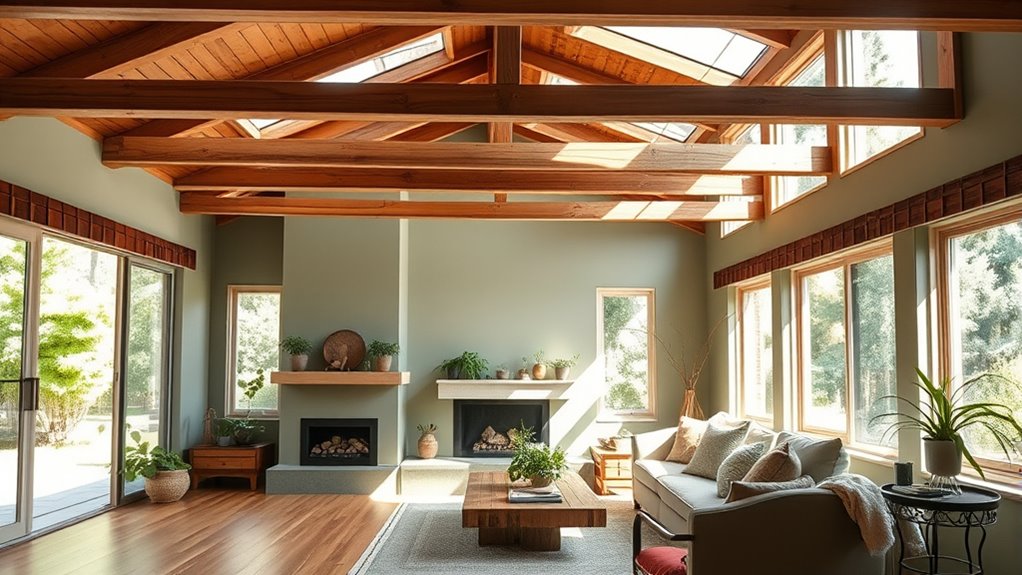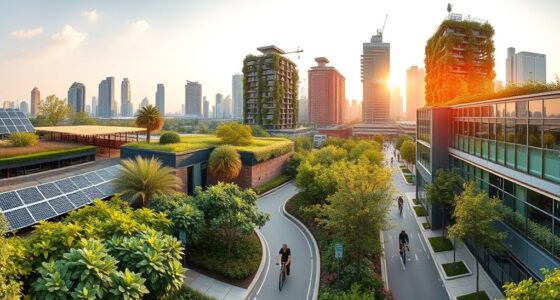When renovating your home sustainably, consider using reclaimed wood for its unique character and eco-benefits. Upgrade your energy efficiency with proper insulation, smart thermostats, and LED lighting. Implement water conservation measures like low-flow fixtures and rainwater harvesting systems. To enhance indoor air quality, choose low-VOC materials and invest in advanced air filtration. Incorporating smart home technologies will also help reduce energy use. There are plenty more eco-friendly ideas waiting for you to explore!
Key Takeaways
- Use reclaimed wood for flooring to reduce waste and add unique character while sequestering carbon.
- Incorporate low-VOC paints and Greenguard-certified materials to enhance indoor air quality.
- Install energy-efficient appliances and smart home technologies to minimize energy consumption.
- Implement water conservation measures like low-flow fixtures and rainwater harvesting systems.
- Opt for sustainable insulation like wool or recycled cotton to promote energy efficiency and non-toxicity.
Reclaimed Wood: A Timeless Choice
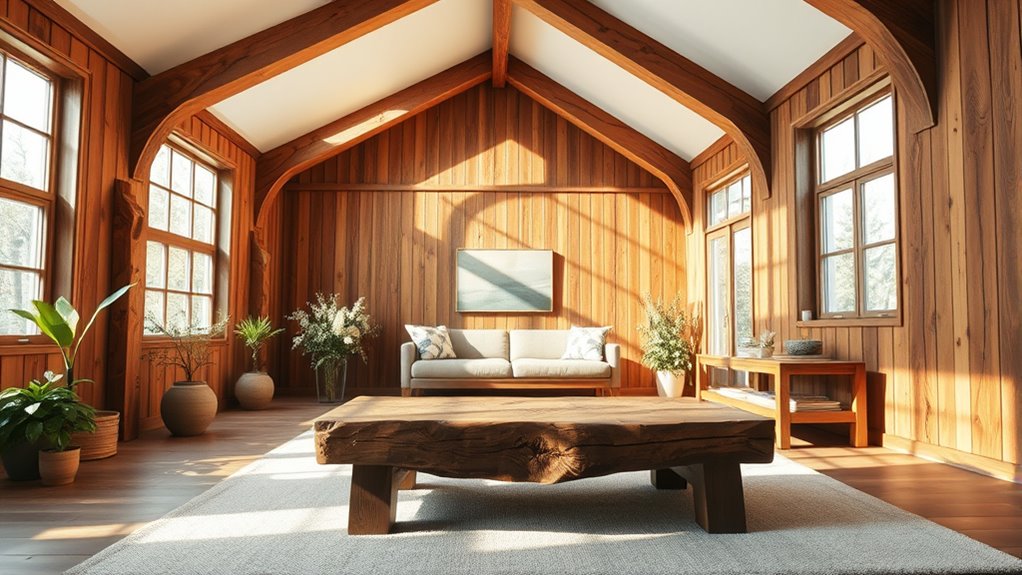
When you're considering sustainable home renovation options, reclaimed wood stands out as a timeless choice. It significantly reduces deforestation, helping preserve forests and biodiversity.
By diverting wood waste from landfills, you contribute to waste reduction and lower environmental pollution. Plus, reclaimed wood continues to sequester carbon, lowering your overall carbon footprint. Additionally, using responsibly managed forests ensures that the wood you choose supports sustainable practices. The incorporation of natural elements further promotes a tranquil environment in your home. Furthermore, reclaimed wood can be paired with energy-efficient lighting to enhance both aesthetics and sustainability.
Not only is it environmentally friendly, but it's also incredibly durable. Coming from old-growth trees, it's denser and less prone to warping, ensuring longevity in your home.
The unique aesthetics of reclaimed wood bring character and warmth to any space, making it versatile for various design styles. Many historic farmhouses also utilize reclaimed wood, showcasing sustainable farming practices that promote eco-friendly renovations.
Ultimately, choosing reclaimed wood is both a smart investment and a stylish addition to your sustainable home renovation.
Energy Efficiency Upgrades for a Greener Home

Energy efficiency upgrades can transform your home into a greener, more sustainable space while significantly lowering your utility bills.
Start with proper insulation and air sealing, which can cut your energy use by around 10%. These cost-effective upgrades enhance your heating and cooling systems. Additionally, consider using air purifiers to improve indoor air quality, which can complement your energy efficiency efforts. Installing solar panels can further amplify your energy savings by harnessing renewable energy.
Consider installing heat pumps—air source or ground source—offering efficient heating and cooling while using less energy than traditional systems. Regular maintenance of these systems can enhance their efficiency by up to 70% efficiency improvement over time, allowing you to benefit from energy savings that can offset installation costs.
Don't forget to switch to LED lighting and Energy Star appliances, as they can drastically reduce your energy consumption.
Lastly, look into renewable energy options like solar panels, which not only lower your bills but also increase your home's value.
Incentives and tax credits can help make these upgrades more affordable.
Water Conservation Measures to Reduce Usage
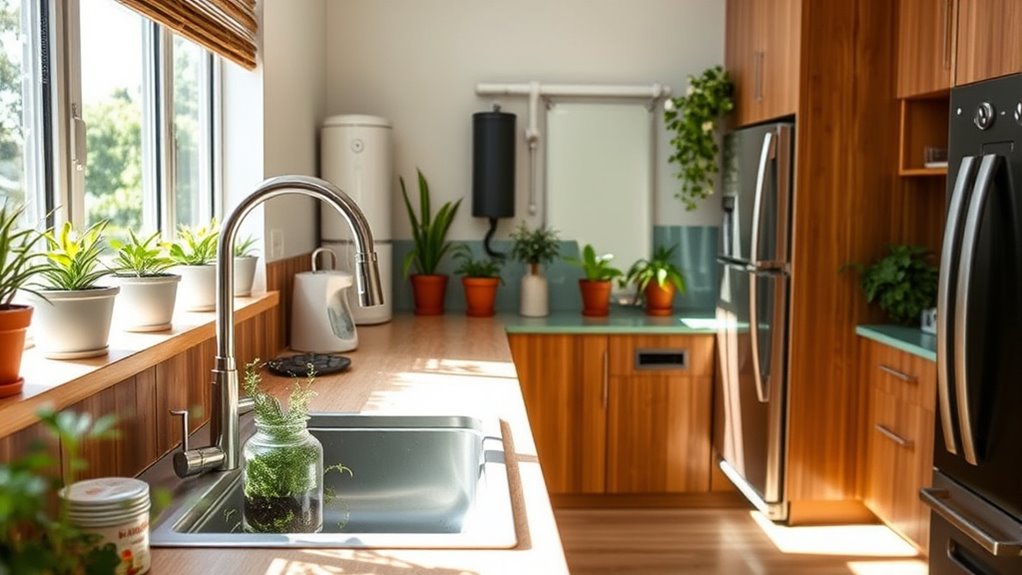
To create a more sustainable home, implementing water conservation measures is essential for reducing usage and minimizing your environmental impact.
Start by installing low-flow fixtures, which can significantly cut water consumption in your bathroom and kitchen. Additionally, ensure that all installations comply with local building codes, as this contributes to both safety and efficiency. Consider incorporating portable camping toilets in outdoor areas to further enhance your water conservation efforts. Using waterproofing treatments on outdoor installations can help them withstand the elements while reducing water waste.
Consider rainwater harvesting systems to collect water for outdoor use, or set up greywater systems to recycle water from your sinks and showers.
Choose drought-resistant plants for your garden to lower outdoor water needs.
Incorporate smart watering practices, like using drip irrigation and watering during cooler times of the day.
Lastly, fix leaks promptly and monitor your water usage regularly to identify areas for improvement. These strategies not only save water but also promote a greener lifestyle. Additionally, conducting energy audits can help identify other areas of your home that may benefit from increased efficiency, further supporting your sustainability efforts.
Enhancing Indoor Air Quality
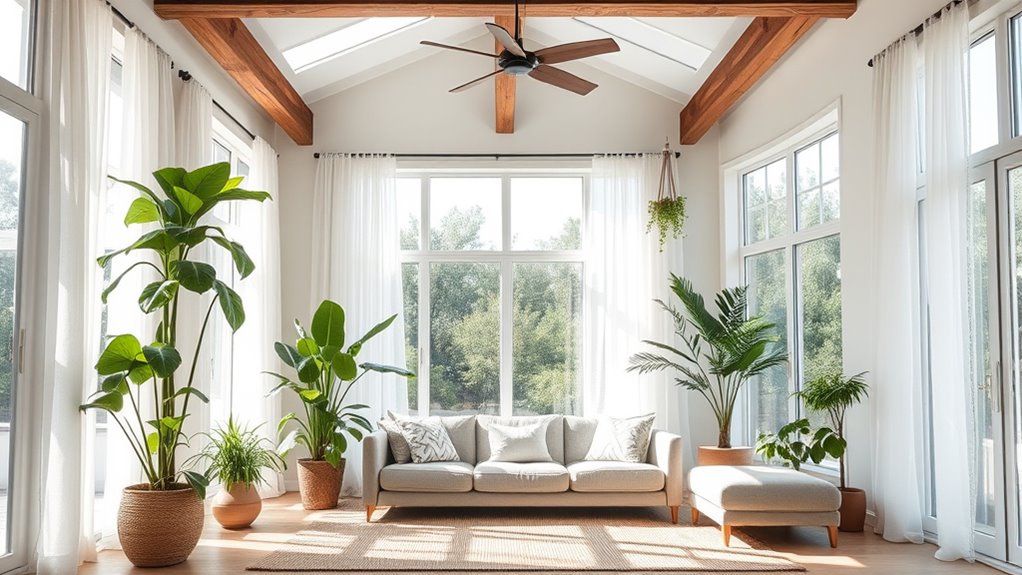
How can you create a healthier living environment? Start by choosing low-VOC and non-toxic materials for your renovation.
Opt for Greenguard-certified products to ensure low emissions and select formaldehyde-free plywood and PVC-free flooring to minimize harmful chemicals. Incorporate antimicrobial materials to combat mold growth effectively. Additionally, consider investing in best home security systems that not only protect your home but also enhance indoor air quality through improved ventilation. Implementing HEPA filtration can further help in capturing tiny airborne particles and enhancing your indoor air quality.
Enhancing ventilation is also crucial. Consider natural ventilation through operable windows or smart systems that adjust airflow based on air quality.
Implement advanced filtration technologies, like high-efficiency filters and UV light purifiers, to capture airborne pollutants. Air purifiers that utilize HEPA filters can significantly reduce allergens and improve overall well-being.
Finally, monitor your indoor air quality with real-time systems, ensuring you address any issues promptly.
Eco-Friendly Renovation Practices

As you embark on your renovation journey, embracing eco-friendly practices can significantly impact both your home and the environment.
Start by conducting energy audits to pinpoint areas for improvement and set clear sustainability goals to guide your efforts. Research green certifications, like GreenPoint Rated, to ensure your choices align with sustainable standards. Mindful decluttering can help create a more efficient space and reduce the need for excess materials. Work with experts who specialize in eco-friendly design to make informed decisions, including those who understand tiny house requirements to further enhance sustainability. Additionally, consider how backyard greenhouses can serve as a valuable asset in your renovation by promoting sustainable living through homegrown food.
Conduct energy audits, set sustainability goals, and collaborate with eco-friendly design experts for informed renovation choices.
When choosing materials, opt for recycled options, reclaimed wood, and low-VOC paints to enhance indoor air quality. Installing energy-efficient appliances and high-performance insulation will lower your energy bills. Additionally, consider incorporating a backyard greenhouse to extend your gardening season and promote the growth of your own sustainable food sources.
Lastly, prioritize deconstruction over demolition to salvage reusable materials. By implementing these practices, you'll create a healthier home while supporting a sustainable future.
Smart Home Technologies for Sustainability
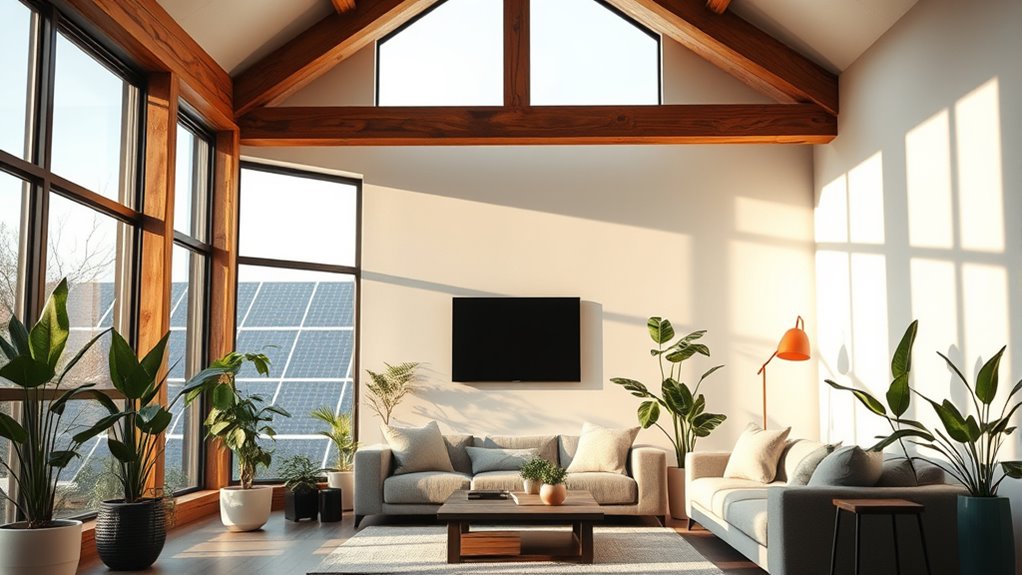
What if you could enhance your home's sustainability while enjoying modern conveniences? Smart home technologies make this possible.
Start with smart thermostats that learn your schedule, optimizing heating and cooling to save energy. Automated lighting systems use smart LED bulbs that turn off in unoccupied rooms, cutting down waste. Additionally, using smart home technologies can streamline these processes further, making energy management even more efficient. Chia farming techniques, such as integrated pest management, can serve as inspiration for managing your home environment efficiently.
You can monitor energy usage with smart plugs and devices, easily eliminating phantom power consumption. Consider smart appliances that adjust their settings based on load size, conserving both water and energy. Additionally, integrating heat pumps can significantly reduce energy consumption and enhance your home's overall efficiency. These systems utilize the refrigeration cycle to efficiently transfer heat, providing both heating and cooling.
By integrating these technologies with renewable energy sources like solar panels, you can maximize your home's efficiency.
Embracing smart home innovations not only simplifies your life but also contributes to a more sustainable future.
Choosing Sustainable Materials for Your Project
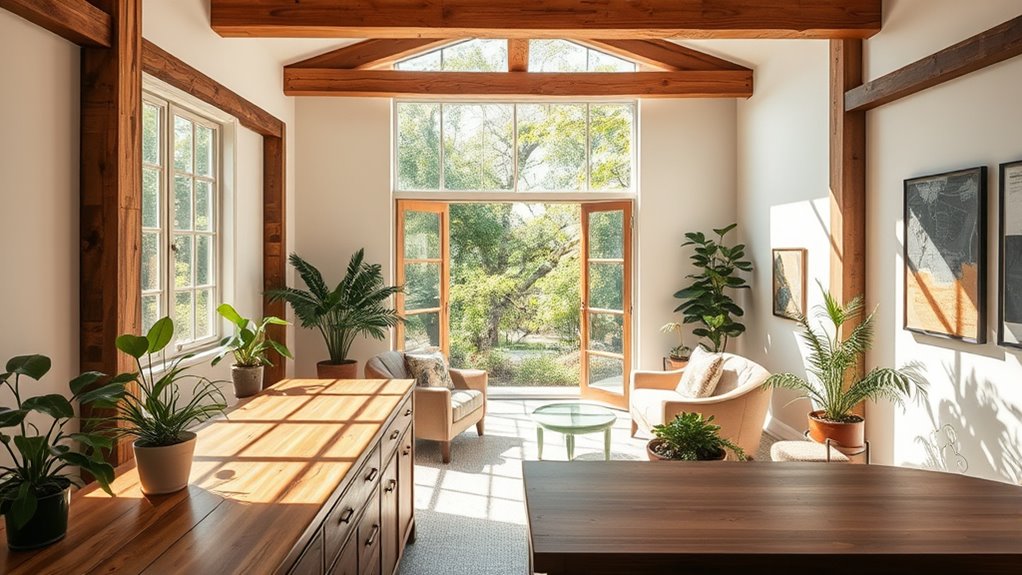
Incorporating smart home technologies not only enhances your home's efficiency but also sets the stage for choosing sustainable materials in your renovation project.
Opt for bamboo or reclaimed wood for flooring, as they're renewable and reduce timber demand. Consider recycled glass for countertops; it conserves resources and adds visual appeal.
When painting, choose low-VOC options to improve indoor air quality. Insulate with wool or recycled cotton to keep your home energy-efficient and non-toxic.
For roofing, metal is both recyclable and energy-saving. Lastly, don't forget energy-efficient windows and appliances to cut down on energy bills. Additionally, implementing energy-efficient heat pumps can further enhance your home's sustainability while reducing energy costs.
Frequently Asked Questions
What Are the Costs Associated With Sustainable Home Renovations?
When considering the costs associated with renovations, you'll notice that sustainable options often come with higher initial expenses.
For instance, energy-efficient lighting can cost around $240, while solar panel installations can range from $10,000 to $30,000.
However, you'll save significantly on utility bills over time, and government incentives can help offset those upfront costs.
Exploring financing options can also ease the financial burden, making these renovations more manageable for you.
How Can I Find Local Sustainable Material Suppliers?
Did you know that sourcing materials locally can cut carbon emissions by up to 50%?
To find local sustainable material suppliers, start by checking local building associations and online directories. Join community forums and social media groups for recommendations, and keep an eye out for local government initiatives promoting sustainable practices.
Attending trade shows can also connect you with suppliers committed to eco-friendly materials. You're sure to discover valuable resources right in your area!
Are There Financial Incentives for Sustainable Renovations?
Yes, there are financial incentives for sustainable renovations.
You can take advantage of federal tax credits for energy-efficient upgrades, which can save you money on your taxes. Many states offer additional rebates and low-interest financing options as well.
Utility companies might provide grants for eligible projects too. By researching local and federal programs, you can significantly reduce the costs of your renovations while making your home more energy-efficient.
How Long Do Sustainable Materials Typically Last?
Sustainable materials last like a well-tended garden, thriving over time.
Timber can endure for centuries if maintained properly, while bamboo and cork flooring often last decades with minimal upkeep.
Natural fibers like wool also offer durability, and recycled materials can provide lasting strength.
Can I Renovate My Home Sustainably on a Budget?
Yes, you can renovate your home sustainably on a budget.
Start by focusing on energy-efficient lighting and smart thermostats, which both save money in the long run. Use low-VOC paints to improve air quality and consider recycling materials for your projects.
Invest in sustainable flooring options like bamboo or cork, and look for government incentives to offset costs.
With some planning and creativity, you'll create a greener home without breaking the bank.
Conclusion
As you embark on your sustainable home renovation journey, think of your home as a garden—each choice you make is a seed planted for a greener future. By embracing reclaimed wood, energy-efficient upgrades, and eco-friendly materials, you're not just building a house; you're nurturing an environment that thrives. With every conscious decision, you're cultivating a sanctuary that breathes, grows, and flourishes, reflecting your commitment to sustainability. Let your home be a beacon of hope for generations to come.
